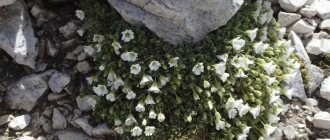Author: Elena N. https://floristics.info/ru/index.php?option=com_contact&view=contact&id=19 Category: Garden plants Published: February 28, 2019Last edits: April 26, 2021
- When to plant
- How to care
- Care after flowering
- Chrysanthemum grandiflora
Chrysanthemum is rightly called the queen of autumn - for its luxurious flowering until frost. But not every queen can boast of such stamina and character! The most cold-resistant specimens can bloom even until mid-December, and if the flowering bush is transplanted into a pot in time, then you have every chance to admire the chrysanthemum blooming until Christmas! Chrysanthemum is also considered an ideal cut flower crop. With proper care, bouquets of chrysanthemums remain fresh for a whole month. Chrysanthemum easily endures long trips. Easy to care for, cold and drought resistant. It would seem that this flower is absolutely self-sufficient. But it will still be useful for an attentive gardener to know some nuances of care.
- Why can chrysanthemum flowers become smaller?
- How to make a winter “blanket” for chrysanthemums?
- When and why do you need to dig chrysanthemums into a trench?
Read our article.
Planting and caring for chrysanthemums
- Planting: sowing seeds in open ground in May or for seedlings in April. You can sow before winter, no later than two weeks before the onset of frost.
- Flowering: late summer, autumn.
- Lighting: bright sunlight.
- Soil: dry, well-drained, nutritious, loamy, slightly acidic or neutral.
- Watering: plentiful.
- Fertilizing: 3 times per season alternately with mineral and organic fertilizers in liquid form. The first feeding is 7 weeks after planting.
- Reproduction: annuals - only by seeds, perennial species and varieties most often vegetatively (by dividing the bush and cuttings).
- Pests: nematodes, aphids, meadow bugs.
- Diseases: gray rot, rust, septoria, powdery mildew, bacterial root canker.
Read more about growing chrysanthemums below.
Chrysanthemum (lat. Chrysanthemum) - herbaceous perennials and annuals of the Asteraceae or Asteraceae family. Translated from Greek it means “golden-flowered” or “sun flower”, since many species have yellow inflorescences. According to the GRIN website, this genus contains 29 species in nature, distributed in the northern and temperate zones, mostly in Asia. Archaeologists claim that more than 2500 years ago, the chrysanthemum was already cultivated by the ancient Chinese, who ate its petals as food, and in the treatise “Spring and Autumn” it was mentioned by Confucius himself! Then the Japanese began cultivating the flower, idolizing this flower so much that only members of the imperial family had the right to wear clothes with the image of a chrysanthemum. The chrysanthemum appeared in Europe in the eighteenth century, but it began to be intensively cultivated only in the nineteenth.
Scientists believe that the now widely known garden chrysanthemum (Chrysanthemum hortorum) appeared as a result of crossing two Asian species - the small-flowered chrysanthemum (Chrysanthemum indicum), which comes from Japan, and the large-flowered chrysanthemum (Chrysanthemum morifoolium) from China, but some breeders are confident that the ancestors Garden chrysanthemums are small-flowered Indian chrysanthemums and Chinese chrysanthemums. The chrysanthemum is so popular among breeders that experiments on developing new varieties do not stop to this day, especially since for humanity the chrysanthemum is not just a beautiful flower, but the last sonorous chord in the autumn symphony of flowers and colors...
- Growing alyssum seedlings
Fertilizing in spring for lush flowering
For lush flowering in the climate of the Moscow region, plants need enhanced feeding.
Chrysanthemum most needs the following substances:
- Nitrogen (needed for proper leaf development);
- Potassium – stimulates active root growth;
- Phosphorus - increases chrysanthemum immunity to diseases, pests and parasites. Phosphorus is also needed to increase the number of buds;
- Copper and zinc - for the formation of green mass.
It is known that the plant’s need for certain minerals depends on the variety. If the bush is tall, you should feed it with nitrogen fertilizers more often. For compact varieties of small stature, potassium fertilizers are more important.
Good results are obtained by applying humus and organic fertilizers made independently from weed residues. In the spring, you must add manure or poultry droppings. Before applying any fertilizer to the ground, it is necessary to thoroughly water and loosen the soil. This is necessary for intensive and rapid absorption of nutrients.
To increase the duration of flowering and speed up the process of setting buds, industrially produced stimulants should be used. Which one to choose depends on the grower. The product “Bud” is very popular.
If the soil is poor in nutrients, it is unlikely that you will be able to wait for lush flowering.
You should think in advance about how to feed chrysanthemums in the garden in spring for lush flowering. To do this, flower growers begin to stock up on complex mineral fertilizers in winter. Beginning gardeners should feed chrysanthemums responsibly, never exceeding the recommended dose of fertilizer. You also need to know how to fertilize chrysanthemums - not all types of fertilizing are suitable.
For fertilizing, it is necessary to use nitrogen, phosphorus and potassium fertilizers. Nitrogen accumulates in small tubers on the roots of the plant and contributes to the active growth of green mass. A good result is given by the industrially produced drug “Kemira”, its updated version is “Kemira +”. To apply fertilizer, the mixture must be diluted with water, strictly observing the proportions, diagram and detailed recommendations indicated on the package. The drug "Kemira" stimulates the growth of chrysanthemums, flowering and bud setting. Flowers appear large, even, without deformation. A powerful remedy is the drug “Multiflor”, which guarantees long flowering and helps to bloom faster. You can also use a time-tested folk remedy - an infusion of garden weeds.
Not all fertilizers are suitable for chrysanthemums
Attention! When preparing a decoction of weeds, all seeds should be removed in advance. If this is not done, the weeds will multiply again and choke the chrysanthemum.
Botanical description
Among chrysanthemums there are perennial plants, and there are annual chrysanthemums, there are herbaceous species, and there are subshrubs. The rhizome of chrysanthemums is branched, developing parallel to the surface. The shoots may be bare or pubescent. Chrysanthemum leaves, arranged alternately, are simple, but different in size and shape - notched, jagged, dissected - may also be pubescent, or may not be. The leaf color is usually light green, although it can be dark.
Small flowers are collected in a basket, sometimes quite large, usually consisting of single-row tubular middle and reed-shaped marginal flowers, although in many hybrid varieties the flowers are arranged in multi-rows, forming a dense inflorescence called double chrysanthemum. The fruit of a chrysanthemum is an achene. The culture uses species and varieties of the so-called garden chrysanthemum, or mulberry chrysanthemum. Sometimes it is called Chinese chrysanthemum. This is a complex group of varieties and hybrids, their history is quite confusing.
How to choose the right seedlings?
When purchasing seedlings, pay attention not only to the overall healthy appearance of the plant, but also to the quantity and quality of buds. The buds should already begin to open and show the tips of the flower petals. Then your chrysanthemum will definitely bloom after planting in the ground! If the plant is purchased with green buds, the flowers may not open.
Growing chrysanthemums from seeds
Sowing seeds
Chrysanthemums are most easily propagated by cuttings and dividing queen cells, but often chrysanthemums grown from seeds are a source of special pride for breeders. Seed propagation is used in the cultivation of both perennial (for example, Korean chrysanthemums) and annual species. We will tell you how to grow chrysanthemums using the example of seed propagation of annual species.
How to grow asters from seeds - a detailed guide
In May, after spring frosts, 2-3 seeds are placed in holes located 20-25 cm from each other and spilled with warm water and, sprinkled with soil, cover the bed with garden film to retain heat and moisture in the soil. As soon as the seedlings hatch, the film must be removed and the soil carefully loosened, destroying the weeds. After ten days, the seedlings need to be fed with heavily diluted Ideal or Rainbow. When the sprouts reach a height of 7-10 cm, leave one strong seedling with 3-4 true leaves in the hole; you can plant the remaining sprouts in another place. Your annuals will bloom in early August. If you want chrysanthemums to bloom early, you need to first grow seedlings from seeds.
Growing seedlings
Seedlings need to be grown at room temperature in shallow boxes with a soil mixture consisting of equal parts of greenhouse soil, humus and peat. It is better to purchase the mixture in a store where it is sold after disinfection and disinfestation, but if you decide to make it yourself, then do not forget to sift and calcinate it at a temperature of 110-130 ºC. Place broken bricks or expanded clay at the bottom of the box to create a drainage layer, then place the soil mixture and spread the seeds on it. The seeds of annual chrysanthemums are sprinkled with a 0.5 cm layer of soil; the seeds of perennial chrysanthemums are not covered, but only lightly pressed to the soil.
Now spray the surface with water from a spray bottle, cover the boxes with film or glass and keep at a temperature of 23-25 ºC, ventilating and spraying with warm water from time to time so that the soil does not dry out.
Unless something unexpected happens, seedlings should appear in one and a half to two weeks. Now move the containers to the brightest place and begin to gradually accustom the seedlings to the environment, removing the glass or film first for one hour, then for two, and so on, until it’s time to remove the coating completely. If the seedlings are too dense, then when 2-4 leaves (not cotyledons, but real ones) appear, they are dropped into cups with the same soil mixture, trying not to damage the roots of the chrysanthemum seedlings. To do this, before picking, moisten the soil in the boxes abundantly. Seedlings that are weakened or too elongated are discarded. After picking, the seedlings are sprayed with a solution of Zircon or Epin to help them take root faster.
In the photo: Chrysanthemum seedlings
Seedling care
Picked chrysanthemum seedlings are kept in a room with a temperature of 16-18 ºC, watered when necessary, and fed twice a month with a solution of complex fertilizer. If necessary, additional fluorescent illumination will be arranged. Be prepared for the seedlings to grow slowly: after a month and a half they will become about 20 cm in height.
Soil preparation
In open ground, species adapted for frosty winters grow safely - these are zoned varieties grown from seeds; they winter well, and then grow and bloom.
Before planting, you should choose a location. Flowers do not like shade, otherwise the plant will reach for the sun and will not have the strength to bloom. The area should be windless and moderately damp, without stagnant water. The soil for bush chrysanthemum must meet certain requirements:
- Soft fluffy soil should not contain clay; any mechanical composition will be suitable.
- Good air and water circulation is required.
- Peat and fertilizers are added to the planting hole to make the soil slightly acidic and fertile.
For digging, 20 kg of humus, 30 g of urea and 100 g of superphosphate are introduced per square meter. If there is heavy soil, sand is sprinkled for drainage. It is forbidden to add fresh manure under chrysanthemums.
Planting and propagation of chrysanthemums
When to plant
Chrysanthemum seedlings are planted in the spring when the return frosts have passed, at the end of May or beginning of June. Chrysanthemums are also planted in autumn, no later than two weeks before frost sets in.
When choosing a site for chrysanthemum, you need to remember that this plant is heat-loving, light-loving and does not tolerate stagnation of water in the roots, so the planting site should be elevated, well-lit by the sun for at least five hours a day and reliably protected from the wind.
The soil is preferably neutral or slightly acidic, nutritious and loamy. Sandy or clay soil must be improved with organic fertilizers. But chrysanthemum does not like unrotted manure, preferring humus or vermicompost, which are applied to the soil before planting chrysanthemums along with complex fertilizer. Just do not overdo it with fertilizers, so that the plants do not gain green mass to the detriment of flowering.
How to plant
To plant chrysanthemums in open ground, choose a cloudy, or even better, rainy day. It is better to plant chrysanthemums not in holes, but in a trench, keeping a distance of 30-50 cm between seedlings, depending on the variety and type. After planting, it is advisable to water the trench with a root solution at the rate of 1 g per liter of water so that the plants quickly form their root system. Immediately after planting and watering, pinch - remove the growing point of the chrysanthemum. Now cover the seedlings with a covering material (for example, lutrasil) to create the most favorable microclimate for them to take root and grow. Remove the covering when you are sure that the seedlings have taken root and are growing.
- Chionodoxa: cultivation and care, types and varieties
Cuttings
Another method of propagating chrysanthemums is cuttings. In the spring, when the daytime temperature reaches 21-26 ºC, using a sharp, clean knife, cut cuttings from the mother plant (side shoots are not suitable, only those shoots that grow directly from the root of the chrysanthemum) a few millimeters above the leaf with the bud, the length of the cutting should be 6-7 cm. The lower end of the cuttings is dipped in a growth stimulator (Kornevin, for example) and stuck into a container with moist nutrient soil, covered with 2 cm of sand, at an angle of 35-45º. The cutting should remain in the sand without touching the ground. While the chrysanthemum cuttings are rooting on a light windowsill, the soil in the container should be moist and the air temperature 15-18 ºC, and then after 2-3 weeks the cuttings will take root and can be transplanted into open ground.
Watering
Large-flowered chrysanthemums are moisture-loving plants. And they need regular and abundant watering. The slightest lack of moisture will lead to a deterioration in the decorativeness of flowers. Therefore, moisten the bushes 2-3 times a week as soon as the top layer of soil dries. For watering, use rain or settled water. Irrigate the bushes strictly at the root, avoiding moisture getting on the leaves.
When the water is absorbed, be sure to loosen the soil. Otherwise, a crust will form on it, blocking the access of air to the roots. And this will have a bad effect on the beauty of the flowers. Remove weeds during the event. To reduce crop maintenance and avoid weeding and loosening, mulch the area with a layer of peat, fallen leaves or humus.
Caring for garden chrysanthemum
How to care
Planting and caring for chrysanthemums is not particularly difficult, but there are certain rules that even an amateur gardener needs to know. For example, when seedlings planted in open ground grow stronger and produce their eighth leaf, they need to be pinched to enhance branching. For the same purpose, you need to pinch the young side shoots that will appear soon, and then you will get a nice, thick bush that will look like a fluffy ball when in bloom. This rule does not apply to large-flowered chrysanthemums; it is better to remove their side shoots altogether, leaving only a few of the strongest ones. Removed shoots take root easily. Some tall varieties of chrysanthemums require support, for which you can use metal pegs, nets or wire structures that will hold the bush and prevent it from falling apart.
How to plant gatsaniya to get abundant flowering
Watering
As for moisture, each watering of chrysanthemums should be plentiful: lack of moisture makes the stems lignified and the flowers less attractive. Only rain or settled water is used (you can add a couple of drops of ammonia). Avoid getting water on the leaves, pour it under the root. Watering is accompanied by loosening the soil around the bush and removing weeds, unless you mulch the area after planting.
Fertilizer
Caring for chrysanthemums also includes mandatory feeding. During the growing season, at least three feedings of chrysanthemums are carried out alternately with mineral and organic fertilizers. Of the mineral ones , at the beginning of growth, chrysanthemums respond best to nitrogen fertilizers (ammonium nitrogen is best), as a result of which the green mass actively increases, and in order to stimulate intensive flowering of the chrysanthemum, feed it with phosphorus-potassium fertilizers during the budding period. Fertilizers are used by plants in the form of solutions that are poured under the roots the day after rain or watering. The first feeding should take place in the first 6-8 weeks after planting. Among organic fertilizers, chrysanthemums love burnt mullein or bird droppings, but the gardener’s golden rule is that it is better to underfeed the plant than to burn it.
How to transplant
A chrysanthemum should not grow in one place for more than three years, otherwise it begins to act up: the flowers become smaller, the plant begins to get sick often. Therefore, in the spring you need to dig up plants that are three years old and replant them. Usually, replanting chrysanthemums is accompanied by dividing the bush - another way to propagate chrysanthemums. Carefully dig up the bush, trying not to damage the roots, shake off the soil and use a sharp knife or pruning shears to divide the thickened bush into small bushes with roots. Now plant these bushes in a sunny area in the usual way.
Diseases and their treatment
If you allow lush thickets to form in the area where chrysanthemums grow or do not follow the rules of agricultural technology for these plants, you can expose chrysanthemums to fungal diseases:
- Verticillium wilt (the fungus penetrates the roots, causing the leaves to turn yellow and the stems to die);
- powdery mildew (affects shoots, leaves, buds and flowers, covering them with a harmful white coating);
- rust (all above-ground organs of the plant become covered with chlorotic spots, which then turn brown, the leaves turn yellow, the stems become thinner);
- gray rot (blurred brown spots appear, becoming covered over time with a fluffy coating that causes rotting).
Fungal infections can be treated with preparations containing copper - copper oxychloride, for example, successfully fights septoria, gray mold and rust. Bordeaux liquid destroys powdery mildew and gray rot, and copper-soap emulsion and colloidal sulfur destroy rust. But the main thing is not to allow chrysanthemums to grow randomly, to follow the rules of plant care and to detect diseases in a timely manner in order to save the chrysanthemums.
Unfortunately, sometimes chrysanthemums suffer from viral diseases:
- mosaic (speckled mosaic on chrysanthemum leaves);
- aspermia (mottling of leaves and deformation of flowers);
- dwarfism (stunted growth and premature flowering).
Plants affected by viral diseases, unfortunately, are incurable, so they need to be detected, dug up and destroyed in a timely manner. As a preventive method of protection against viruses, it is necessary to use sterile instruments during vegetative propagation and fight against insects that carry viruses.
Pests of chrysanthemums
Of the insects, nematodes most often harm chrysanthemums, whose presence can be detected by the appearance of mosaic spots on the leaves, which darken over time. It is already useless to fight this problem, but as a preventative measure, before digging up or planting (transplanting) chrysanthemums in the autumn, spray the plants with a Phosfamide solution and treat the soil with formaldehyde. Specimens affected by the nematode must be destroyed.
How dangerous is the cockchafer - how to deal with it
Another pest of chrysanthemums is aphids, which settle on the lower part of the leaf or bud. The insects themselves, as well as their larvae, suck the juice from the plant, which slows down the growth and flowering of chrysanthemums. If you are dealing with a single colony of aphids, then it is destroyed along with the leaves on which it has settled, but if the plant is covered with aphids, spray it with Actellik or Aktara with the addition of laundry soap.
In the photo: How chrysanthemums bloom
Sometimes a meadow bug settles on a chrysanthemum, which, together with its larvae, just like aphids, feeds on plant sap. Consequence: the buds do not open, the leaves become spotted, turn brown and die. Spray the plant affected by bugs with a solution of baby shampoo (1 teaspoon per 10 liters of water). As a preventative measure, chrysanthemum bushes are treated with phosphamide.
A danger to chrysanthemums are garden slugs and snails , which can devour leaves, flowers and plant stems.
- Oregano: cultivation, types and varieties
But when dealing with them, you need to use an organic approach, that is, use gentle control methods so as not to disturb the garden ecosystem, in which snails and slugs perform an important sanitary function.
Therefore, preventive measures to combat them are welcomed in gardening: the correct selection and combination of plants, natural control over the number of pests by attracting birds, and so on. If trouble happens and slugs begin to devour your chrysanthemums, collect them by hand, dig plastic rims around the bushes that prevent slugs from getting to the bushes, sprinkle the ground around the bushes with crushed eggshells, which will prevent the snails from getting closer to the plants... Finally, place them in the flower garden bowls with beer and after a while collect your “harvest” of slugs around them.
How to feed chrysanthemums
If you follow the agricultural techniques for growing the flower “queens” of autumn gardens, they grow quickly. By summer, a large bush develops from a small, inconspicuous cutting, and by autumn it already manages to please us with abundant flowering and goes into a dormant state. With such accelerated development, frequent feeding becomes a necessity. There should be at least three of them over the summer.
The first time the chrysanthemum needs to be fed until mid-June, that is, even before the buds form on the plant. It will help the bush grow green mass. The fertilizer can be prepared from the following ingredients:
- 10 liters of settled water;
- 1 tbsp. spoon of nitrophoska;
- 1 liter of liquid mullein.
Before fertilizing, the bushes need to be watered thoroughly and wait for moisture to be absorbed into the soil. Then about 1 liter of nutrient solution is added to each plant.
The second time chrysanthemums are fed during the bud setting period, from the second ten days of July to the second ten days of August. A more precise date depends on the specific flowering time of each species. For the second feeding you can take:
- 10 liters of water;
- 1 tbsp. a spoonful of superphosphate;
- 1 tbsp. a spoonful of potassium sulfate.
It is carried out in the same way: about 1 liter of nutrient solution is poured under each bush, the soil is pre-moistened.
The third time, fertilizing is carried out at the height of abundant flowering. It is prepared as follows:
- 10 liters of water;
- 1 tbsp. spoon of potassium sulfate.
Otherwise everything is the same. The earth is pre-watered abundantly. Apply 1 liter of liquid fertilizer to each bush.
Fertilizer is best applied at dawn or late in the evening after the sun has set. Care must be taken to ensure that the nutrient liquid does not get on the flowers and leaves, as the chemicals it contains will cause them to burn.
To ensure that as many buds as possible form on the chrysanthemum, it blooms faster, and the flowering is friendly, before they begin to swell, the bushes are sprayed with a growth stimulator Bud for rapid flowering at the rate of 10 g of stimulant per 10 liters of settled water. To spray 10-15 plants you will need 1 liter of this solution. You can also use Bon forte fertilizer for roses and bush chrysanthemums.
Chrysanthemums have faded - what to do
Care after flowering
At the beginning of autumn, feed your frost-resistant chrysanthemums one last time with potassium-phosphorus fertilizers to increase their resistance to frost. With the onset of frosts, chrysanthemums overwintering in the garden (primarily varieties of Korean chrysanthemums with small flowers) cut off the above-ground part at a height of 10-15 cm from the surface, carefully hill up and mulch the planting with a layer of dry leaves 30-40 cm thick. If winters are in your area too cold and snowless, cover the area on top of the mulch with brushwood or spruce branches. The shelter should not be impenetrable, because plants should not rot under such a “blanket”.
In the photo: Yellow chrysanthemums
How to preserve chrysanthemums in winter
Tall, large-flowered, heat-loving varieties are unable to survive our winter in open ground. Various methods are used to store them. Here is one of them: the mother chrysanthemum bushes, extracted with a clod of earth, are placed in wooden boxes and stored in a bright and cold room (2-6 ºC) with an air humidity of about 80%. If you don't have many bushes, plant each of them in a separate container. Water the chrysanthemums from time to time to keep the soil slightly moist. You can simply store mother bushes with earthen clods in the cellar at a temperature of 0-4 ºC on an earthen floor, placing them tightly next to each other.
Growing home chrysanthemum - planting and care
There is another way to store chrysanthemums. To do this, dig a trench 50 cm deep of any width in the garden, into which chrysanthemum queen cells are placed, the distance between which is filled with earth. Chrysanthemums are stored in an open trench until the coldest weather to destroy pathogens of fungal and viral diseases. With the onset of frost, the trench is covered with boards or a wooden board, slate cloth or some other material that forms a “cover” for the ditch, on which leaves are poured, earth is placed on top of the leaves, and then a covering material is laid, which is secured so that it does not blow away by the wind. This method is inconvenient because it will be difficult for you to control the condition of the plants in winter.
Well, and finally, a reminder:
- small-flowered, Korean chrysanthemums and Russian hybrids overwinter well in open ground;
- chrysanthemums grown in greenhouses should be dug up for the winter, as well as large-flowered chrysanthemums, foreign hybrids and new varieties of chrysanthemums about which you know little.
Reproduction methods
How to grow chrysanthemums? If you plant them with seeds, you will not preserve the variety, so it is best to use one of the other possible methods:
- dividing bushes;
- cuttings;
- separation of root shoots.
Chrysanthemums can be planted and replanted only in the spring, preferably in May, when there are definitely no frosts or sudden cold snaps. If you postpone the planned event to the beginning of summer, the flowers will not suffer one bit.
If you bought planting material at the beginning of autumn or at the end of summer, do not delay planting. Try to plant the plants in open ground no later than September 15th. Otherwise, before the onset of frost, the roots of chrysanthemums simply will not have time to grow stronger. If you missed this moment, do it differently: just cut the cuttings and place them in indoor pots until the weather warms up.
Just place the flowerpots in a dark room with a low temperature of about 4-6 degrees, which will not change until spring. For example, a heated terrace or loggia may be suitable. Throughout the winter, all you need to do for maintenance is to periodically water the plants.
At the end of February, chrysanthemums can be moved to the greenhouse. There they will need to be watered much more often. And by the end of March, when the seedlings have grown, it will be possible to make cuttings by cutting off shoots up to 10 cm long.
Cut cuttings should be placed in a box with soil, humus and sand and covered with glass. It usually takes a month for plants to develop their root system, after which they can be transplanted into open ground.
Types and varieties
Despite the outstanding successes of breeders in developing new species and varieties of chrysanthemums, there is still no unified classification system for these plants. In Germany, France and China they are divided into 10 classes, and in England and America - into 15. We will introduce you to several, in our opinion, more successful.
Classifications based on flower size and bush height:
Chrysanthemum grandiflora
Luxurious large chrysanthemums (flower diameter 10-25 cm, average height 80-120 cm) of different shapes of inflorescences, grown mainly for cutting. Most often, this type of chrysanthemum does not overwinter in open ground, but recently varieties have been developed that can be left in the garden for the winter:
- Anastasia Green – green needle-shaped chrysanthemums, bush 80-100 cm tall, blooms from October, overwinters in the ground, but requires shelter;
- chrysanthemum Zembla Lilac - very large double pink chrysanthemums, wide petals, bush height 90 cm, winters in the garden. The Zembla series potted forms are very popular;
- Tom Pierce - red chrysanthemum, the reverse side of the petal is orange, the shape of the flower is spherical, diameter - 22 cm, bush height - 150 cm, blooms from September;
In the photo: Chrysanthemum grandiflora Anastasia Green
Chrysanthemum medium-flowered
It is called decorative. The diameter of the flowers is 10-18 cm, the height of the bushes is 30-70 cm. It is grown not only in the garden, but also in pots, decorating balconies and terraces with them. Can also be used for cutting. Here are the varieties that grow well in the garden:
- Splash of champagne - bush chrysanthemum, bush height - 70-90 cm, needle-shaped inflorescence of light pink color with a yellowish coating in the center, there is a variety with golden flowers, diameter 8-10 cm. Blooms from October until frost, overwinters well in the ground;
- Golden Fleece - yellow-orange chrysanthemum, height - 40-60 cm, blooms from the end of September, winters in the garden;
- Pink chamomile is actually a dark pink chrysanthemum daisy, the diameter of the flower is 6-8 cm, the height of the bush is 60-90 cm. It blooms in September and blooms until frost, overwinters in the ground.
In the photo: Chrysanthemum grandiflora Tom Pierce
Small-flowered chrysanthemum, or Korean chrysanthemum
Frost-resistant perennial chrysanthemums, popularly called “oaks” for the shape of the leaves, which are similar to oak leaves. Bushes 25-120 cm high, numerous inflorescences, both simple and double, of various colors. Easy to care for, reproduces well, grows in any soil for up to 4 years. It blooms in mid-September and blooms until frost. Inflorescences with a diameter of 2 cm to 10 cm. The aroma of these chrysanthemums resembles the smell of wormwood. They winter well in open ground:
- Etna - a bush 60-80 cm high, lilac needle-shaped flowers with a diameter of 6-8 cm, blooms from October;
- Slavyanochka – 40-60 cm tall, pink chrysanthemums with a bright center, blooms from the end of September;
- Multiflora is a new selection of chrysanthemum that has become incredibly popular lately. It can be grown both in open ground and in a container or pot. It blooms early, sometimes even in August, has a spherical bush shape and a wide range of colors.
In the photo: Medium-flowered chrysanthemum Pink chamomile
Classification according to the shape of the inflorescences:
Simple chrysanthemums
- non-double (Ben Dickson, Pat Joice);
- semi-double (Amazon, Baltika, Natasha;
- anemone-shaped (Vivien, Beautiful Lady, Andre Rose).
In the photo: Chrysanthemum medium-flowered Multiflora
Terry chrysanthemums
- bent (Regalia, Tracy Waller);
- flat (Swan Song, Valli Ruf);
- hemispherical (Gazella, Zlata Praha, Trezor);
- spherical (Arctic, Kremist, Broadway);
- radiate (Pietro, Magdalena, Tokio);
- pompons (Denis, Fairie, Bob);
- arachnids (Spring dawn on the Su-Ti dam, Gratsia).
Classification by flowering time:
Early varieties
- chrysanthemum Zembla yellow - yellow large-flowered chrysanthemums of spherical shape, diameter 15 cm, blooms from September;
- Deliana - white, needle-shaped chrysanthemums, 16 cm in diameter, bloom in September;
- Handsom - lilac-colored daisy chrysanthemums with a white border. Blooms from September;
Medium flowering varieties
- Orange – spherical chrysanthemums, bright yellow, 20 cm in diameter, bloom in October;
- Anastasia lil - needle-shaped lilac flowers 20 cm in diameter. They bloom in October;
- Froggies are small, spherical green flowers that bloom in October.
Late varieties
- Avignon - spherical flowers 20 cm in diameter, light pink, blooms from November;
- Rivardi - yellow balls 20 cm in diameter, bloom in November;
- Larisa - white daisies with a yellow center, the beginning of flowering is November.
In the photo: Chrysanthemum Zembla yellow
In addition, chrysanthemums are divided into annuals:
Chrysanthemum keeled, or tricolor
Densely branched, height 20-70 cm, fleshy stem, leaves petiolate, twice pinnately divided, inflorescences - large baskets, simple, semi-double or double, 5-7 cm in diameter. Reed flowers are white or yellow with a reddish edge, tubular flowers are dark red. Varieties:
- Flammenstahl – yellow-brown center, red flowers;
- Nordstern - large white flowers with a yellow-red center;
- Cockade - simple white flowers with a carmine base bloom in June and bloom until September;
In the photo: Chrysanthemum Orange
Chrysanthemum field, or sowing
Height 30-60 cm, branches well, leaves at the bottom of the stem are pinnate, at the top - serrated. The flowers resemble field daisies, white with a yellow center, 3-5 cm in diameter. Popular varieties:
- Helios – golden yellow chrysanthemums;
- Stern des Orients - light yellow flowers, dark center;
In the photo: Chrysanthemum Froggy
Chrysanthemum crown
Tall (40-100 cm), shoots are densely leafy with pinnate divided leaves, there are areas of serrated, lanceolate leaves. Inflorescences are up to 3 cm in diameter, the color of tubular flowers is yellow-green, the color of reed flowers is from yellow to white.
- Tetra comets – semi-double, large-flowered variety of various colors
...and perennial chrysanthemums,
which include almost all of the above-described species and varieties.
There is also Scott's classification of chrysanthemums, created in 1951. Among flower scientists it is considered detailed and convenient, but for amateurs it is complex, so we will not waste your time.
Storing chrysanthemums in winter
Large-flowered varieties of chrysanthemums, dug out of the ground for the winter, are stored in greenhouses or basements at a temperature of 8-10 degrees Celsius. In order for the plant to overwinter better, it is advisable to cover its root system. A layer of sand, peat, humus or a dense layer of leaves will do just fine. It is easier to deal with small-flowered varieties (white and lilac in the photo), for which for the winter, without digging, we must cover the root system with any non-woven material, since severe frosts can damage the roots of the plants, which will subsequently lead to their death.
Chrysanthemums are decorative for up to 6 years, then their inflorescences become smaller. To prevent this from happening, every 4 years we transplant the plant bushes in our dacha to a new location.
When to plant
It is necessary to plant flowering chrysanthemums very carefully, because any damage to the root system can have a detrimental effect on its development. It is recommended to plant plants in late September or October, when the weather is still quite warm.
To carry out such an event, it is better to choose a cloudy and slightly cool day, when the air temperature at night is about 0 degrees. In our region, it’s still quite warm at night, but I still took the risk of planting seedlings. I think this is not critical. During the day it was about +15 on the day of landing, and at night it was about +7.
Photos of large chrysanthemums
Gardeners share photos of tall, large-flowered chrysanthemums in their plots.
Chrysanthemums of different shades look great together in one area
To decorate the area, you can plant flowers along the entire length of the fence.
Compositions are brighter if you combine specimens of different shades
Diseases and pests
Large chrysanthemums are susceptible to gray rot and downy mildew. To prevent and combat these diseases, plants are treated with fungicides.
Among insect pests, nematodes pose a particular danger to crops. Symptoms of damage include black, confluent spots on the lower leaves. Infected chrysanthemums cannot be treated. They must be burned to prevent damage to healthy flowers.
Important! After removing the chrysanthemums on which the nematode has settled, the crop cannot be planted in this area for several years.
Care after flowering
This applies to those types of chrysanthemums that will remain outside in the winter. To make it easier for them to endure the winter, you need to feed them for the last time in September, and when the first frosts occur, it is recommended to trim the chrysanthemums so that only small shoots, about 10-15 cm in height, remain on the surface.
Ideally, additionally insulate the rhizomes of plants with fallen leaves. If your region has harsh winters, it is additionally recommended to add spruce branches or brushwood to the foliage.
It is not recommended to cover chrysanthemums with film or other materials that do not allow air to pass through, because in this case the plant will rot a lot, and subsequently get sick, or even die.











